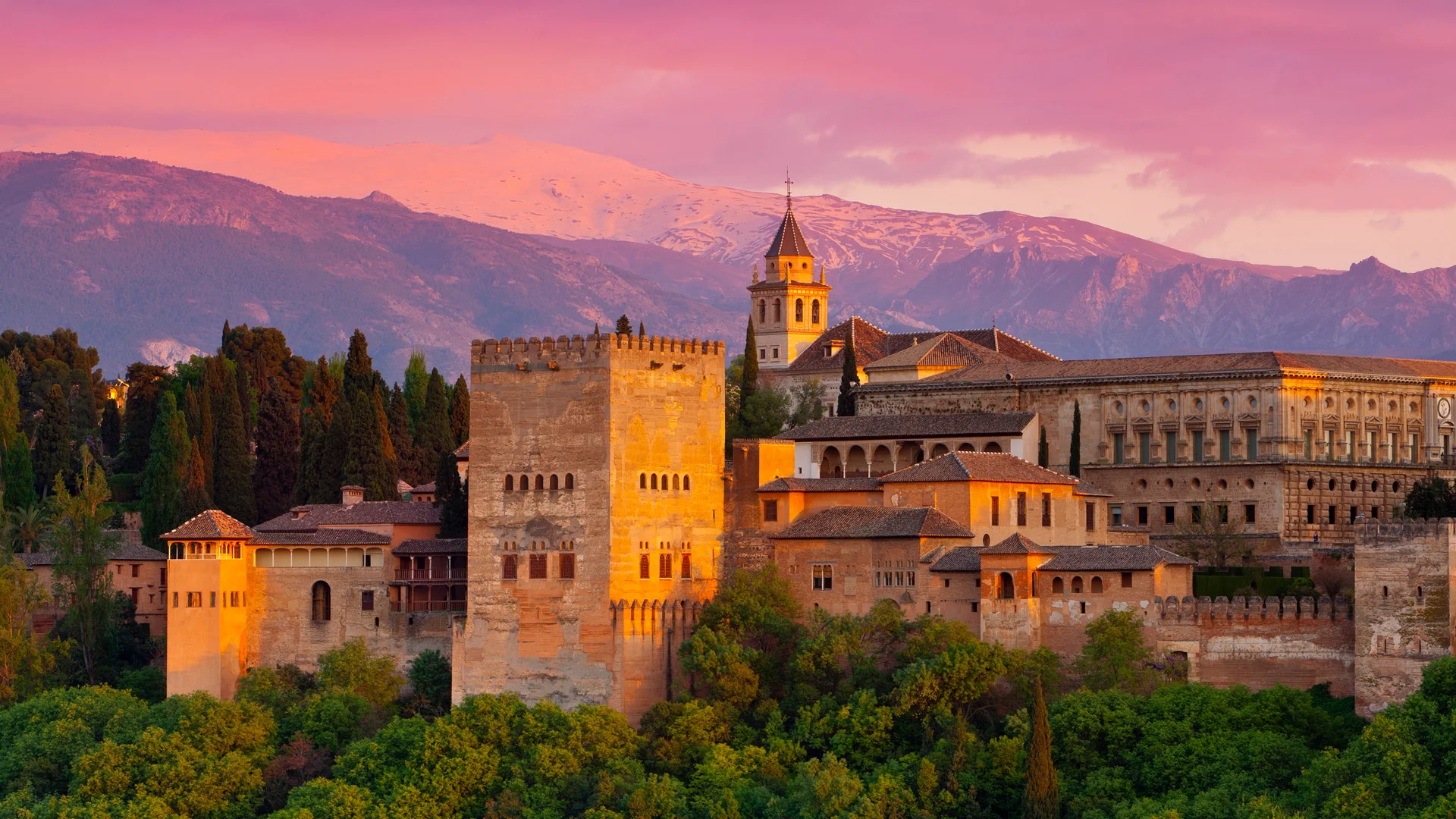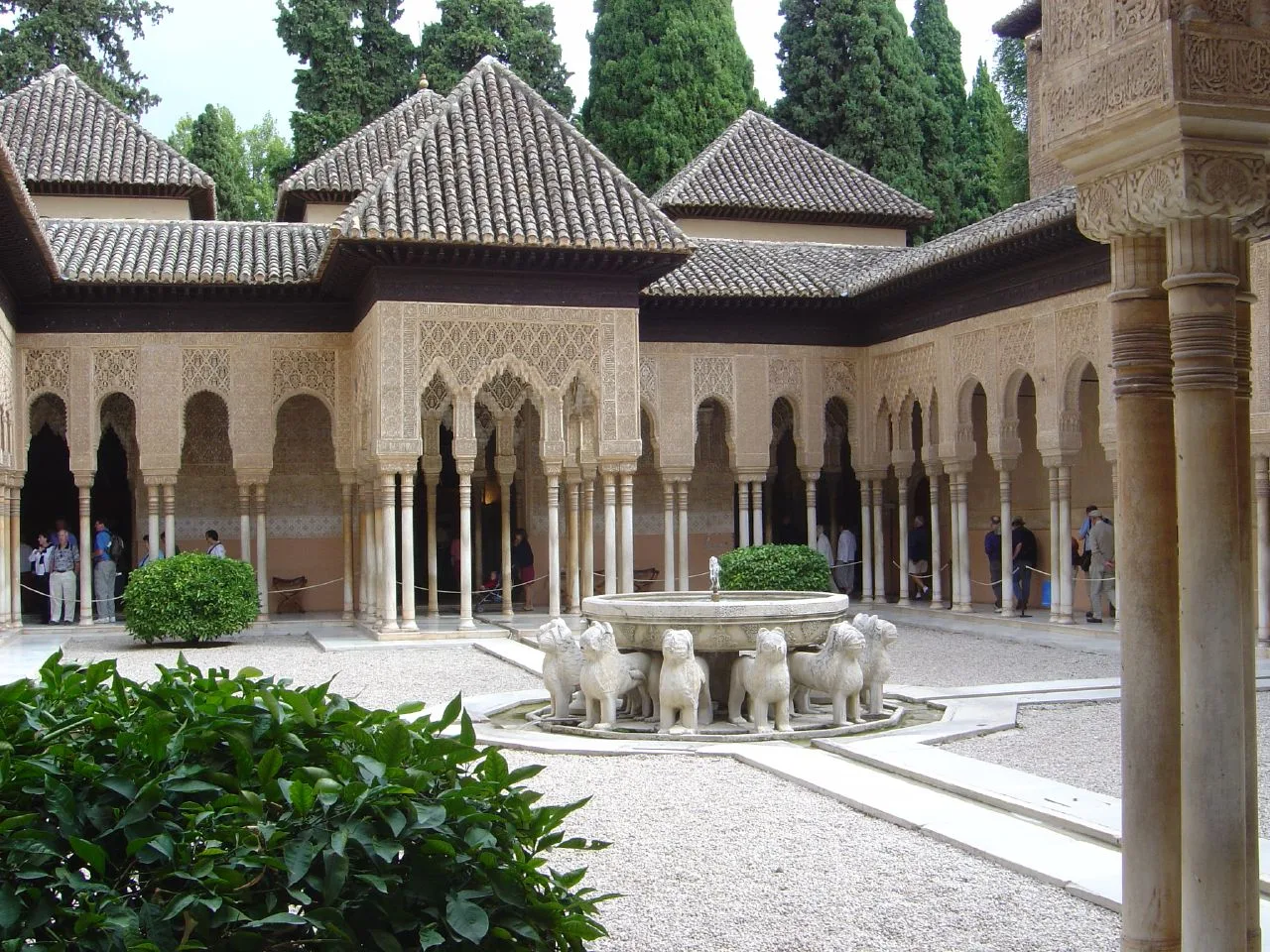 |
| Alhambra Fortress Granada Spain |
The Alhambra is an impressive architectural and park ensemble that includes ancient palaces, a fortress, and gardens of Muslim rulers and is considered the highest achievement of Moorish architects in Western Europe. Currently, the Alhambra is a museum of Islamic art and culture, which is visited annually by millions of tourists from all over the world.
The Alhambra is located on top of a rocky plateau in the eastern part of the city of Granada in southern Spain. Medieval poets described this structure as an "emerald pearl", noting the expressive structure against the backdrop of green forests, blue skies, and mountainous landscapes with snow-capped peaks of the Sierra Nevada.
The name "Alhambra" literally translates from Arabic as "red castle". Some attribute this to the color of the sun-dried clay from which the palaces are built, others believe that the name comes from the "red flames of torches" that illuminated the Fortress during many years of construction.
 |
| Alhambra Fortress Granada Spain |
History of the Alhambra
The development of the Alhambra is associated with the Muslim conquerors of the Iberian Peninsula, who came to the territory of southern Spain in the 8th century. During the reign of the Muslim Nasrid dynasty (1230-1492), Granada became the capital of the Moorish possessions in Spain - the Granada Emirate.
The Moorish emirs wished to create a piece of earthly paradise on the conquered lands of sunny Spain - this is how the Alhambra arose among the shady gardens of Granada, which became the residence of the emirs-conquerors. In those days, the vast complex, enclosed in fortress walls with towers, included mosques, residential buildings, baths, gardens, warehouses, and a cemetery; the palaces of the Alhambra, dating mainly from the XIV century, have survived to this day.
 |
| Alhambra Fortress Granada Spain |
Alhambra Gardens
The interior of the complex can be described as harmoniously combining the picturesque gardens of the Alhambra, courtyards, and terraces with fountains, water cascades, canals, and ponds with many graceful arches, vaults, slender columns, or patterned carved windows. All this splendor is decorated with bizarre Arabic patterns, floral ornaments, colorful mosaics, ceramic tiles, wood, and stone carvings.
Water and light play an important role in the overall composition of the Alhambra. The water here sparkles with a spray of fountains, murmurs in the canals, and brisk streams in cascades, filling reservoirs. All this - on a vast territory, surrounded by fragrant orange trees, cypress alleys, and flowering flower beds.
 |
| The territory of the Alhambra, Granada Alhambra, Granada |
The water coming from the mountain slopes of the Sierra Nevada filled the canals and fountains of the Alhambra and was the element that the Moors valued most of all. Fountains, streams, and waterfalls are no less characteristic of the architecture for the Arabs than the columns are for the Greeks. It is no coincidence that the inscription on the fountain in the Lion's Courtyard is preserved: "Look at the water and look at the reservoir, and you will not be able to decide whether the water is calm or marble is flowing."
 |
Interior of the Alhambra Palace |
The road to the Alhambra from Granada follows the slope of the Cuesta de Gomeres through a parkland that stretches from the Pomegranate Gate to the Gate of Justice, which was the main entrance to the Alhambra in Moorish times.
On the huge arches of the gates in the shape of a horseshoe are preserved inscriptions in Arabic script: “Praise God. There is no God but Allah, and Mohammed is his prophet. There is no other authority than God. "
Alhambra Architecture
The Alhambra is a complex of courtyards, rooms, passages, and towers, each of which had its original purpose and have its own characteristics. The very names of many of them are eloquent: "Myrtle courtyard", decorated with evergreen myrtle tapestries.
 |
| The interior of the Alhambra |
The Hall of the Two Sisters gets its name from the two huge slabs of white marble embedded in the floor. The tiling and stucco decoration of the Hall of the Two Sisters is perhaps the finest in the entire Alhambra. The honeycomb dome is the largest of the Arab stalactite vaults, with about 5,000 cells.
"The courtyard of the lions" is named so thanks to the fountain around which the statues of twelve predators froze.
The Chamber of Ambassadors was created for court celebrations of official ceremonies. The dome of this room is decorated with a star pattern that shimmers at high altitudes.
Of particular interest are the numerous towers of the Alhambra with decorated halls, swimming pools, and beautiful views of the surrounding area from the tops of the towers. The easternmost part of the Alhambra Palace is occupied by the defense tower of Torre de las Damas, with an adjoining vaulted hall, a swimming pool, and a small mosque.
 |
| Alhambra Fortress Granada Spain |
In sharp contrast to the rest of the architecture of the ensemble, the later building is the palace of Carlos V, built on the territory of the Alhambra in the 16th century by order of the Roman king Charles V. The square structure hides a circular courtyard with an Ionic colonnade on the upper floor and Tuscan columns on the lower one. Currently, the palace is a concert venue for music and dance performances. The interior of the palace of Carlos V houses the Archaeological Museum of the Alhambra and the Museum of Fine Arts of Granada.
Tickets to the Alhambra
Tickets to the Alhambra are sold for one of the periods: morning, afternoon, or evening. You need to come strictly within the specified period.
Opening hours of the Alhambra:
from 8.30 to 14.00, from 14.00 to 18.00, and from 20 to 21.30 hours in winter - from October 15 to March 14;
from 8.30 to 14.00, from 14.00 to 20.00, and from 22 to 23.30 hours in the summer.
The cost of a general ticket to visit Alhambra is 14 euros
Children 12-15 years old - 8 euros
Children up to 12 years old free
Adults 65 and older and EU pensioners - 9 euros
Disabled people - 8 euros
The cost of an evening visit - 8 euros
Guided tour - 55 euros
Tickets can be purchased at the box office (cash) and terminals (bank cards) at the entrance. Tickets are valid only on the day of purchase, so it is better to come for tickets with a reserve.
We advise you to buy your tickets in advance at the Tienda de la Alhambra store in Granada or by calling Bank La Caixa: 902 88 80 01 for Spain or +34 958 926 031 for calls from abroad.
The average length of the route through the Alhambra complex is 3.5 km. For comfortable sightseeing of all sights, it will take at least 3 hours.